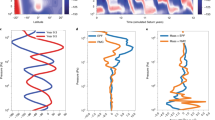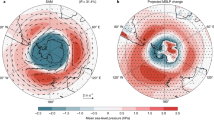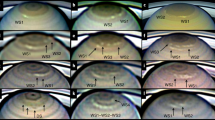Abstract
Saturn displays cyclonic vortices at its poles and the general atmospheric circulation at other latitudes is dominated by embedded zonal jets that display cyclonic circulation. The abundance of small-scale convective storms suggests that convection plays a role in producing and maintaining Saturn’s atmospheric circulation. However, the dynamical influence of small-scale convection on Saturn’s general circulation is not well understood. Here we present laboratory analogue experiments and propose that Saturn’s cyclonic circulation can be explained by tilted convection in which buoyancy forces do not align with the planet’s rotation axis. In our experiments—conducted with a cylindrical water tank that is heated at the bottom, cooled at the top and spun on a rotating table—warm rising plumes and cold sinking water generate small anticyclonic and cyclonic vortices that are qualitatively similar to Saturn’s convective storms. Numerical simulations complement the experiments and show that this small-scale convection leads to large-scale cyclonic flow at the surface and anticyclonic circulation at the base of the fluid layer, with a polar vortex forming from the merging of smaller cyclonic storms that are driven polewards.
This is a preview of subscription content, access via your institution
Access options
Access Nature and 54 other Nature Portfolio journals
Get Nature+, our best-value online-access subscription
$29.99 / 30 days
cancel any time
Subscribe to this journal
Receive 12 print issues and online access
$259.00 per year
only $21.58 per issue
Buy this article
- Purchase on Springer Link
- Instant access to full article PDF
Prices may be subject to local taxes which are calculated during checkout




Similar content being viewed by others
References
Dyudina, U. A. et al. Dynamics of Saturn’s south polar vortex. Science 319, 1801 (2008).
Boubnov, B. M. & Golitsyn, G. S. Experimental study of convective structures in rotating fluids. J. Fluid Mech. 167, 503–531 (1986).
Fernando, H. J. S., Chen, R.-R. & Boyer, D. L. Effects of rotation on convective turbulence. J. Fluid Mech. 228, 513–547 (1991).
Maxworthy, T. & Narimousa, S. Unsteady, turbulent convection into a homogeneous, rotating fluid, with oceanographic applications. J. Phys. Oceanogr. 24, 865–887 (1994).
Condie, S. A. & Rhines, P. B. A convective model for the zonal jets in the atmospheres of Jupiter and Saturn. Nature 367, 711–713 (1994).
Read, P. L. et al. Dynamics of convectively driven banded jets in the laboratory. J. Atmos. Sci. 64, 4031–4052 (2007).
Stewartson, K. On the slow motion of an ellipsoid in a rotating fluid. Q. J. Mech. Appl. Maths 6, 141–162 (1953).
Loper, D. E. On the structure of a Taylor column driven by a buoyant parcel in an unbounded rotating fluid. J. Fluid Mech. 427, 131–165 (2001).
Sheremet, V. A. Laboratory experiments with tilted convective plumes on a centrifuge: a finite angle between the buoyancy force and the axis of rotation. J. Fluid Mech. 506, 217–244 (2004).
Davidson, P. A. The dynamics and scaling laws of planetary dynamos driven by inertial waves. Geophys. J. Int. 198, 1832–1847 (2014).
O’Neill, M. E., Emanuel, K. A. & Flierl, G. R. Polar vortex formation in giant-planet atmospheres due to moist convection. Nat. Geosci. 8, 523–526 (2015).
Rossby, C. G. On displacements and intensity changes of atmospheric vortices. J. Mar. Res. 7, 175–187 (1948).
Flor, J. B. & Eames, I. Dynamics of monopolar vortices on a topographic beta-plane. J. Fluid Mech. 456, 353–376 (2002).
Fletcher, L. N. et al. Temperature and composition of Saturn’s polar hot spots and hexagon. Science 319, 79–81 (2008).
Barbosa Aguiar, A. C., Read, P. L., Wordsworth, R. D., Salter, T. & Yamazaki, Y. H. A laboratory model of Saturn’s North Polar Hexagon. Icarus 206, 755–763 (2010).
LeBeau, R. P. & Dowling, T. E. EPIC simulations of time-dependent, three-dimensional vortices with application to Neptune’s Great Dark Spot. Icarus 132, 239–265 (1998).
Afanasyev, Y. D., Rhines, P. B. & Lindahl, E. G. Velocity and potential vorticity fields measured by altimetric imaging velocimetry in the rotating fluid. Exp. Fluids 47, 913–926 (2009).
Román, F. L., Faro, J. & Velasco, S. A simple experiment for measuring the surface tension of soap solutions. Am. J. Phys. 69, 920–921 (2001).
Fincham, A. & Spedding, G. Low cost, high resolution DPIV for measurement of turbulent fluid flow. Exps. Fluids 23, 449–462 (1997).
Pawlak, G. & Armi, L. Vortex dynamics in a spatially accelerating shear layer. J. Fluid Mech. 376, 1–35 (1998).
Kestin, J., Sokolov, M. & Wakeham, W. A. Viscosity of liquid water in the range –8 ºC to 150 ºC. J. Phys. Chem. Ref. Data 7, 941–948 (1978).
King, E. M., Stellmach, S. & Aurnou, J. M. Heat transfer by rapidly rotating Rayleigh-Bénard convection. J. Fluid Mech. 691, 568–582 (2012).
Marshall, J., Adcroft, A., Hill, C., Perelman, L. & Heisey, C. A finite-volume, incompressible Navier Stokes model for studies of the ocean on parallel computers. J. Geophys. Res. 102, 5753–5766 (1997).
Marshall, J., Hill, C., Perelman, L. & Adcroft, A. Hydrostatic, quasi-hydrostatic, and nonhydrostatic ocean modeling. J. Geophys. Res. 102, 5733–5752 (1997).
Acknowledgements
This research was supported by the Natural Sciences and Engineering Research Council of Canada.
Author information
Authors and Affiliations
Contributions
Y.D.A. designed the experiment, analysed data, developed the theory, performed numerical simulations and wrote the manuscript. Y.Z. performed the experiment, processed and analysed data and contributed to the manuscript.
Corresponding author
Ethics declarations
Competing interests
The authors declare no competing interests.
Additional information
Publisherʼs note: Springer Nature remains neutral with regard to jurisdictional claims in published maps and institutional affiliations.
Supplementary information
Supplementary Information
Supplementary figures and tables
Rights and permissions
About this article
Cite this article
Afanasyev, Y.D., Zhang, Y. Cyclonic circulation of Saturn’s atmosphere due to tilted convection. Nature Geosci 11, 164–167 (2018). https://doi.org/10.1038/s41561-018-0070-3
Received:
Accepted:
Published:
Issue Date:
DOI: https://doi.org/10.1038/s41561-018-0070-3
This article is cited by
-
Temperature fluctuations and heat transport in partitioned supergravitational thermal turbulence
Acta Mechanica Sinica (2024)
-
The number and location of Jupiter’s circumpolar cyclones explained by vorticity dynamics
Nature Geoscience (2021)



